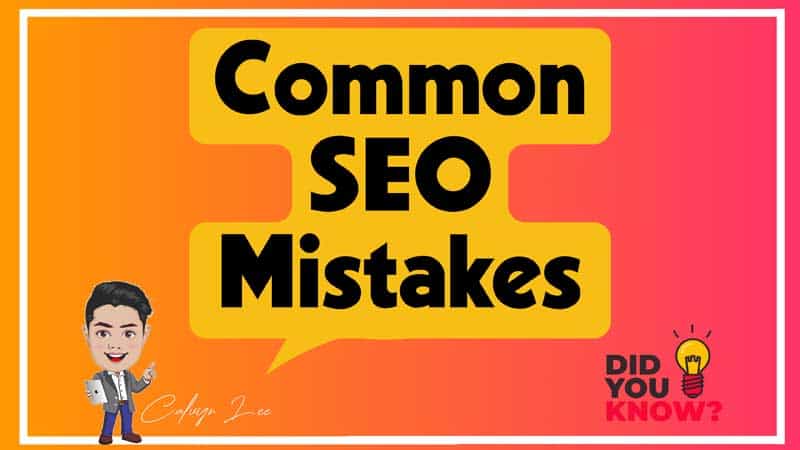When it comes to SEO, small mistakes can cost you big lost rankings, less traffic, and fewer conversions. Below are some of the most common SEO mistakes businesses make, along with simple explanations and examples that will help you avoid them.

Using generic anchor text
Anchor text like “click here” or “read more” doesn’t help search engines understand what the page is about. Instead, use descriptive phrases like “learn digital marketing strategies” to provide context.
Duplicate content
Having the same text appear on multiple pages confuses search engines and may lower rankings. For example, copying product descriptions directly from suppliers is a common issue,
or perhaps you have a blog post talk about “common seo mistakes 2025” and another blog post “common seo mistakes 2026” both serve approximate same content.
Slow site speed
A slow-loading site not only frustrates visitors but also hurts your SEO ranking. Compress images, use caching tools, and CDN to improve loading times.
Keyword stuffing
Overloading text with keywords looks unnatural and can trigger penalties.
Example: writing “common seo mistakes” 15 times in a short article. Instead, use keywords naturally and sparingly.
Overlooking meta tags
Meta titles and descriptions are essential for SEO and click-through rate. A missing or vague description like “Home Page” doesn’t help. A lot of website owner ignoring this part which is a huge mistake.
Unoptimized URL slug
Long, messy URLs with random numbers or symbols are not user-friendly.
For example: calvyn.com/page?id=12345. Better to use: calvyn.com/seo-tips.
Forgetting to add Alt text
Search engines can’t “see” images. Alt text describes what the image is about, improving accessibility and rankings.
Example: instead of leaving blank, use “blue running shoes on white background.”
No internal linking
Without internal links, users and search engines miss important content.
Example: linking from a blog post about SEO basics to your post on keyword research keeps readers engaged.
No external linking
Not linking to credible sources weakens your authority. Pointing to trusted sites like Google developer guidelines or Wikipedia shows you provide valuable, reliable information.
Ultimately, search engines encourage a linking ecosystem.
Outdated content
Old stats or strategies reduce trust and relevance.
Example: still recommending keyword density formulas from 2010 signals your content isn’t fresh.
or your blog still contains an old article about “SEO strategies 2010”
No mobile optimization
Most users are on mobile now-a-days, don’t believe me? Refer “Desktop vs Mobile statistics“. >50% of your client are viewing your website via mobile.
and Google prioritizes mobile-friendly designs.
If your site needs pinch-and-zoom to read text, or swiping left or right. it’s costing you traffic.
No image optimization
Large images slow down your site and don’t help SEO. Compress images and use descriptive filenames like seo-course-banner.jpg.
I saw a lot of websites, photographers give an image, and web developers directly upload it. The image size is like >2 megabytes.
Even for hero section, the large banner images should not be more than 1 megabyte
Low quality content
Thin, unhelpful content won’t rank. A 200-word post stuffed with ads won’t perform; instead, focus on in-depth, reader-friendly articles.
Even you write 1000-word content, but for the sake of writing also won’t help, reader don’t get value from your content.
No keyword research
Writing without research risks missing what your audience is actually searching for.
For instance, targeting “Digital Marketing Course” may be better than “Digital Marketing Class” if search volume is higher.
Ignoring local SEO
Brick-and-mortar businesses often forget local optimization. A lot of your clients are searching for your services.
Eg: “Dental near me“, “Pizza restaurant near me”
Not claiming your Google Business Profile means you lose out on local search traffic.
Irrelevant backlinks
Links from unrelated or spammy sites can hurt rankings. A digital marketing website with backlinks from a gambling site might look suspicious.
Bad user experience
If visitors can’t navigate your site easily, or can’t find the info they need, they’ll leave quickly, which increases bounce rate as well.
Pop-ups, cluttered menus, or hard-to-read fonts push users away, which impacts SEO.
Broken internal links
Links that lead to 404 pages waste SEO value and frustrate visitors.
If you remove your old content, make sure any content that links to this deleted content is removed.
Regularly audit your site to fix or redirect broken links.
These are just some of the most common SEO mistakes that can hurt your SEO strategy. If you want to dig deeper into avoiding these pitfalls and learn actionable techniques, join my SEO Course, where I cover all of these topics step by step and tips to help you improve your rankings and grow your business.

